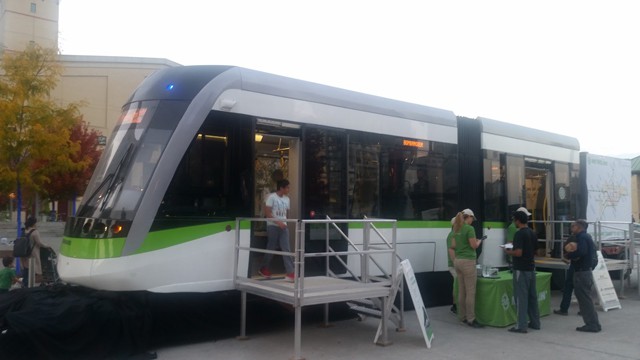City Council Approves Additional $26 Million in Funding for LRT
Published October 19, 2017 at 6:29 pm

Love it or hate it, the upcoming Hurontario LRT project is moving forward in Mississauga and council has approved an additional $26 million ($26,307,000, to be exact) in Additional Municipal Infrastructure (AMI) to be included in the procurement for and the construction of the large-scale transportation project).
According to the City of Mississauga, the AMI includes replacement and upgrades to municipal storm sewers, uninterrupted power supply at all signalized intersections and variable message sign systems within the stop platforms to communicate with MiWay.
Funding for the AMI is the city’s responsibility and will “be integrated with the procurement of the HuLRT Project and completed by the successful contractor.”
Recently, city staff reported at a General Committee meeting on the Metrolinx-led project and made a host of recommendations, including increasing funding for the project that’s set to take shape along Hurontario.
For those who are unaware, the LRT project includes approximately 20 kilometres of new dedicated rapid transit between Port Credit GO Station in Mississauga and Gateway Terminal in southern Brampton, with 22 stops and connections to GO Transit’s Milton and Lakeshore West lines.
Ideally, the LRT—one of the most monumental infrastructure projects Peel has seen in recent years—will provide commuters with a travel option that will cut travel times and help manage congestion across the Greater Toronto and Hamilton Area.
The Hurontario LRT project is part of the largest infrastructure investment in Ontario’s history and the province is providing $1.4 billion to build it in Mississauga and southern Brampton (Brampton famously turned down additional funding to carry the route further down Main Street into the city’s downtown core).
“City staff worked on details for the procurement process such as a request from Metrolinx for an exemption to the City’s Noise Control By-law for timely and cost-efficient construction of the project,” said Geoff Wright, commissioner, Transportation and Works. “We have also identified the opportunity to repair and upgrade city infrastructure during the construction of the LRT to be included in the procurement and are continuing to compile information on potential operating and maintenance costs. Much of this information is dependent on the procurement process and will be part of ongoing discussions with Metrolinx and future agreements.”
As far updates on the project–which is actually slated to break ground next year–go, the request for proposals was issued by Infrastructure Ontario on August 17, 2017 to three pre-qualified, short-listed teams. The contract is anticipated to be awarded in 2018 and the teams include Hurontario Light Rail Connection Partners (HLCP), Mobilinx and Trillium Transit Partners.
As of now, the city is working on a noise by-law exemption.
The city says Metrolinx requested an exemption to the city’s noise control by-law during the construction phase–something council largely supports (although the exemption can be withdrawn if necessary).
As for what to expect in terms of construction, the city provided the following guidelines:
1) Major construction works will take place from 7:00 a.m. to 11:00 p.m., seven days a week, throughout the corridor including:
• concrete placement (track infill, sidewalks curb and gutter, bridge and wall structures, LRT stops)
• aggregate and asphalt placement
• material movement (aggregates, track material and equipment)
• track installation
• testing of the train and systems
2) That the following activities will be allowed 24 hours a day, seven days a week:
• micro tunnelling for water, stormwater, sanitary sewer installation
• install, removal and adjustment of traffic control (construction set up, traffic signal modifications)
3) That the Noise By-Law exemption period be from approximately fall 2018 to the end of construction (planned for 2022)
4) That a limited number of full weekend closures be allowed for segments of Hurontario Street at the following locations:
• Port Credit – bridge works/tunnelling
• QEW – bridge works/tunnelling
• Cooksville GO – bridge works
• Highway 403 – elevated LRT span
As for the aforementioned AMI and increased funding, the city says the proposed infrastructure is beyond the scope of the project and, if approved in principle by council, will be included with the procurement of the LRT.
The total budget for the AMI would be added to the 2018-2027 capital budget and forecast.
The city says provision of LRT operations and maintenance services are included in the procurement process that is currently underway. The responsibility for the costs of those services will be part of future negotiations and the development of an agreement between the city and Metrolinx.
“Prior to Metrolinx reaching financial closure with a successful bid team, an agreement will need to be in place with the City of Mississauga to address the detailed aspects of project delivery and long-term operations and maintenance of the LRT,” said Wright. “We continue to request information from Metrolinx on roles and responsibilities and anticipated operating and maintenance costs.”
Staff is also working on identifying potential short-term and long-term city costs and budget impacts related to the LRT, including roadway and boulevard maintenance and MiWay service.
insauga's Editorial Standards and Policies advertising





